Hedy Lamarr
Hedy Lamarr (/ˈheɪdi/), born Hedwig Eva Maria Kiesler (November 9, 1914[lower-alpha 1] – January 19, 2000), was an Austrian-American actress, inventor, and film producer. She was part of 30 films in an acting career spanning 28 years, and co-invented an early version of frequency-hopping spread spectrum.[1][2]
Hedy Lamarr | |
|---|---|
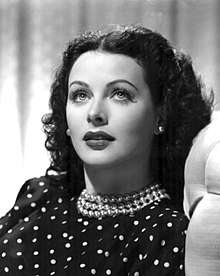 Lamarr in 1944 | |
| Born | Hedwig Eva Maria Kiesler November 9, 1914 |
| Died | January 19, 2000 (aged 85) Casselberry, Florida, U.S. |
| Resting place | Vienna Woods, Austria |
| Citizenship |
|
| Occupation | Actress, inventor, film producer |
| Years active | 1930−1958 |
| Spouse(s) | W. Howard Lee
( m. 1953; div. 1960)Lewis J. Boies
( m. 1963; div. 1965) |
| Children | 3 |
Lamarr was born in Vienna, Austria-Hungary, and acted in a number of Austrian, German, and Czech films in her brief early film career, including the controversial Ecstasy (1933). In 1937, she fled from her husband, a wealthy Austrian ammunition manufacturer, secretly moving to Paris and then onward to London. There she met Louis B. Mayer, head of Metro-Goldwyn-Mayer (MGM) studio, who offered her a movie contract in Hollywood, where he began promoting her as "the world's most beautiful woman".[3]
She became a star with her performance in Algiers (1938), her first film made in the United States.[4] She starred opposite Clark Gable in Boom Town and Comrade X (both 1940), and Jimmy Stewart in Come Live with Me (1941) and Ziegfeld Girl (1942). Her other MGM films include Lady of the Tropics (1939), H.M. Pulham, Esq. (1941), as well as Crossroads and White Cargo (both 1942); she was also borrowed by Warner Bros. for The Conspirators, and by RKO for Experiment Perilous (both 1944). Dismayed by often being typecast, Lamarr co-founded a new production studio and starred in its films: The Strange Woman (1946), and Dishonored Lady (1947).[5] Her greatest success was as Delilah in Cecil B. DeMille's Samson and Delilah (1949).[6] She also acted on television before the release of her final film, The Female Animal (1958). She was honored with a star on the Hollywood Walk of Fame in 1960.[7]
At the beginning of World War II, Lamarr and composer George Antheil developed a radio guidance system for Allied torpedoes, intended to use frequency-hopping spread spectrum technology to defeat the threat of jamming by the Axis powers.[8] She also helped improve aviation designs for Howard Hughes while they dated during the war.[9] Although the US Navy did not adopt Lamarr and Antheil's invention until 1957,[1][10] various spread-spectrum techniques are incorporated into Bluetooth technology and are similar to methods used in legacy versions of Wi-Fi.[11][12][13] Recognition of the value of their work resulted in the pair being posthumously inducted into the National Inventors Hall of Fame in 2014.[8][14]
Early life
Lamarr was born Hedwig Eva Maria Kiesler in 1914 in Vienna, Austria-Hungary, the only child of Emil Kiesler (1880–1935) and Gertrud "Trude" Kiesler (née Lichtwitz; 1894–1977). Her father was born to a Galician-Jewish family in Lemberg (now Lviv, Ukraine), and was a successful bank manager.[15] Her mother was a pianist, born in Budapest to an upper-class Hungarian-Jewish family. She converted to Catholicism as an adult, at the insistence of her first husband, and raised her daughter Hedy as a Catholic as well, though she was not formally baptized at the time.[15]:8
As a child, Kiesler showed an interest in acting and was fascinated by theatre and film. At the age of 12, she won a beauty contest in Vienna.[16] She also began to associate invention with her father, who would take her out on walks, explaining how various technologies in society functioned.[17]
After the Anschluss, she helped get her mother out of Austria and to the United States, where Gertrud Kiesler later became an American citizen. She put "Hebrew" as her race on her petition for naturalization, a term that had been frequently used in Europe.[18]
European film career
Early work
Still using her maiden name of Hedy Kiesler, she took acting classes in Vienna. One day, she forged a permission note from her mother and went to Sascha-Film, where she was hired at the age of 16 as a script girl. She gained a role as an extra in Money on the Street (1930), and then a small speaking part in Storm in a Water Glass (1931). Producer Max Reinhardt cast her in a play entitled The Weaker Sex, which was performed at the Theater in der Josefstadt. Reinhardt was so impressed with her that he arranged for her to return with him to Berlin, where he was based.[19]
Kiesler never trained with Reinhardt nor appeared in any of his Berlin productions. After meeting Russian theatre producer Alexis Granowsky, she was cast in his film directorial debut, The Trunks of Mr. O.F. (1931), starring Walter Abel and Peter Lorre.[20] Granowsky soon moved to Paris, but Kiesler stayed in Berlin to work. She was given the lead role in No Money Needed (1932), a comedy directed by Carl Boese.[21] Her next film brought her international fame.
Ecstasy
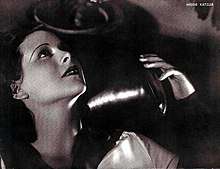
In early 1933, at age 18, Hedy Kiesler, still working under her maiden name, was given the lead in Gustav Machatý's film Ecstasy (Ekstase in German, Extase in Czech). She played the neglected young wife of an indifferent older man.
The film became both celebrated and notorious for showing the actress's face in the throes of an orgasm. According to Marie Benedict's book The Only Woman In The Room, Kiesler's expression resulted from someone sticking her with a pin. She was also shown in closeups and brief nude scenes, the latter reportedly a result of the actress being "duped" by the director and producer, who used high-power telephoto lenses.[22][lower-alpha 2][23]
Although Kiesler was dismayed and now disillusioned about taking other roles, Ecstasy gained world recognition after winning an award in Rome. Throughout Europe, the film was regarded as an artistic work. However, in the United States, it was banned,[24] considered overly sexual, and made the target of negative publicity, especially among women's groups.[22] It was also banned in Germany due to Kiesler's Jewish heritage.[25] Her husband, Fritz Mandl, reportedly spent over $300,000 buying up and destroying copies of the film.[26]
Marriage
Kiesler also played a number of stage roles, including a starring one in Sissy, a play about Empress Elisabeth of Austria produced in Vienna in early 1933, just as Ecstasy premiered. It won accolades from critics.[27][28]
Admirers sent roses to her dressing room and tried to get backstage to meet Kiesler. She sent most of them away, including an insistent Friedrich Mandl.[22] He became obsessed with getting to know her.[29] Mandl was a Viennese arms merchant and munitions manufacturer who was reputedly the third-richest man in Austria. She fell for his charming and fascinating personality, partly due to his immense wealth.[24] Her parents, both of Jewish descent, did not approve, as Mandl had ties to Italian fascist leader Benito Mussolini, and later, German Führer Adolf Hitler, but they could not stop their headstrong daughter.[22]
On August 10, 1933, at the age of 18, Kiesler married Mandl, then 33. The son of a Jewish father and a Catholic mother, Mandl insisted that she convert to Catholicism before their wedding in Vienna Karlskirche. In her autobiography Ecstasy and Me, Mandl is described as an extremely controlling husband. He strongly objected to her having been filmed in the simulated orgasm scene in Ecstasy and prevented her from pursuing her acting career. She claimed she was kept a virtual prisoner in their castle home,[24] Castle Schwarzenau in the remote Waldviertel near the Czech border.
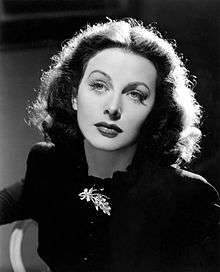
Mandl had close social and business ties to the Italian government, selling munitions to the country,[15] and, despite his own part-Jewish descent, had ties to the Nazi regime of Germany. Kiesler accompanied Mandl to business meetings, where he conferred with scientists and other professionals involved in military technology. These conferences were her introduction to the field of applied science and she became interested in nurturing her latent talent in science.[30]
Finding her marriage to Mandl eventually unbearable, Kiesler decided to flee her husband as well as her country. According to her autobiography, she disguised herself as her maid and fled to Paris. Friedrich Otto's account says that she persuaded Mandl to let her wear all of her jewelry for a dinner party where the influential "Nazi prince" Ernst Stahremberg attended, then disappeared afterward.[26] She writes about her marriage:
I knew very soon that I could never be an actress while I was his wife. ... He was the absolute monarch in his marriage. ... I was like a doll. I was like a thing, some object of art which had to be guarded—and imprisoned—having no mind, no life of its own.[28]:28–29
Hollywood career and adoption of Lamarr surname
Louis B. Mayer and MGM
After arriving in London in 1937,[31] she met Louis B. Mayer, head of MGM, who was scouting for talent in Europe.[32] She initially turned down the offer he made her (of $125 a week), but booked herself onto the same New York-bound liner as he. During the trip, she impressed him enough to secure a $500 a week contract. Mayer persuaded her to change her name from Hedwig Kiesler (to distance herself from "the Ecstasy lady" reputation associated with it).[26] She chose the surname "Lamarr" in homage to the beautiful silent film star, Barbara La Marr, on the suggestion of Mayer's wife, Margaret Shenberg.
.jpg)
When Mayer brought Lamarr to Hollywood in 1938, he began promoting her as the "world's most beautiful woman".[3] He introduced her to producer Walter Wanger, who was making Algiers (1938), an American version of the noted French film, Pépé le Moko (1937).
Lamarr was cast in the lead opposite Charles Boyer. The film created a "national sensation", says Shearer.[15]:77 Lamarr was billed as an unknown but well-publicized Austrian actress, which created anticipation in audiences. Mayer hoped she would become another Greta Garbo or Marlene Dietrich.[15]:77 According to one viewer, when her face first appeared on the screen, "everyone gasped ... Lamarr's beauty literally took one's breath away."[15]:2
In future Hollywood films, Lamarr was often typecast as the archetypal glamorous seductress of exotic origin. Her second American film was I Take This Woman (1940), co-starring with Spencer Tracy under the direction of regular Dietrich collaborator, Josef von Sternberg. Von Sternberg was fired during the shoot, and replaced by Frank Borzage. The film was put on hold, and Lamarr was put into Lady of the Tropics (1939), where she played a mixed-race seductress in Saigon opposite Robert Taylor. She returned to I Take This Woman, re-shot by W. S. Van Dyke. The resulting film was a flop.

Far more popular was Boom Town (1940) with Clark Gable, Claudette Colbert and Spencer Tracy; it made $5 million.[33] MGM promptly reteamed Lamarr and Gable in Comrade X (1940), a comedy film in the vein of Ninotchka (1939), which was another hit.
She was teamed with James Stewart in Come Live with Me (1941), playing a Viennese refugee. Stewart was also featured in Ziegfeld Girl (1941), in which Lamarr, Judy Garland, and Lana Turner played aspiring showgirls; it was a big success.[33]
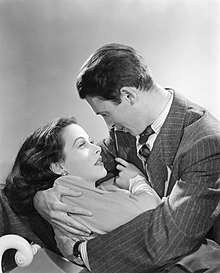
Lamarr was top-billed in H. M. Pulham, Esq. (1941), although the film's protagonist was the title role played by Robert Young. She made a third film with Tracy, Tortilla Flat (1942). It was successful at the box office, as was Crossroads (1942) with William Powell.
She played the seductive native girl Tondelayo in White Cargo (1942), top-billed over Walter Pidgeon. It was a huge hit. White Cargo contains arguably her most memorable film quote, delivered with provocative invitation: "I am Tondelayo. I make tiffin for you?" This line typifies many of Lamarr's roles, which emphasized her beauty and sensuality while giving her relatively few lines. The lack of acting challenges bored Lamarr, and she reportedly took up inventing to relieve her boredom.[34] In a 1970 interview, Lamarr also remarked that she was paid less because she would not sleep with Mayer.[35]
Lamarr was reunited with Powell in a comedy, The Heavenly Body (1944). She was then borrowed by Warner Bros. for The Conspirators (1944), reuniting several of the actors of Casablanca (1942), which had been inspired in part by Algiers and written with Lamarr in mind as its female lead,[36] though MGM would not lend her out.[37] RKO later borrowed her for a melodrama, Experiment Perilous (1944), directed by Jacques Tourneur.
Back at MGM, Lamarr was teamed with Robert Walker in the romantic comedy Her Highness and the Bellboy (1945), playing a princess who falls in love with a New Yorker. It was very popular, but would be the last film she made under her MGM contract.[38]
Personality
Her off-screen life and personality during those years was quite different from her screen image. She spent much of her time feeling lonely and homesick. She might swim at her agent's pool, but shunned the beaches and staring crowds. When asked for an autograph, she wondered why anyone would want it. Writer Howard Sharpe interviewed her and gave his impression:
Hedy has the most incredible personal sophistication. She knows the peculiarly European art of being womanly; she knows what men want in a beautiful woman, what attracts them, and she forces herself to be these things. She has magnetism with warmth, something that neither Dietrich nor Garbo has managed to achieve.[22]
Author Richard Rhodes describes her assimilation into American culture:
Of all the European émigrés who escaped Nazi Germany and Nazi Austria, she was one of the very few who succeeded in moving to another culture and becoming a full-fledged star herself. There were so very few who could make the transition linguistically or culturally. She really was a resourceful human being–I think because of her father's strong influence on her as a child.[39]
Lamarr also had a penchant for speaking about herself in the third person.[40]
Wartime fundraiser
Lamarr wanted to join the National Inventors Council, but was reportedly told by NIC member Charles F. Kettering and others that she could better help the war effort by using her celebrity status to sell war bonds.[41][42]
She participated in a war bond-selling campaign with a sailor named Eddie Rhodes. Rhodes was in the crowd at each Lamarr appearance, and she would call him up on stage. She would briefly flirt with him before asking the audience if she should give him a kiss. The crowd would say yes, to which Hedy would reply that she would if enough people bought war bonds. After enough bonds were purchased, she would kiss Rhodes and he would head back into the audience. Then they would head off to the next war bond rally.[43] In total, Lamarr sold approximately $25 million (over $350 million when adjusted for inflation in 2020) worth of war bonds during a period of 10 days.[1]
Producer
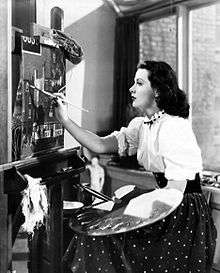
After leaving MGM in 1945, Lamarr formed production company Mars Film Corporation with Jack Chertok and Hunt Stromberg, producing two film noir motion pictures which she also starred in: The Strange Woman (1946), and Dishonored Lady (1947).[44][45][46] Her initiative was unwelcomed by the Hollywood establishment, as they were against actors (especially female actors) producing their films independently.[5] Both films grossed over their budgets, but were not large commercial successes.
Later films
In 1948, she tried a comedy with Robert Cummings, called Let's Live a Little.
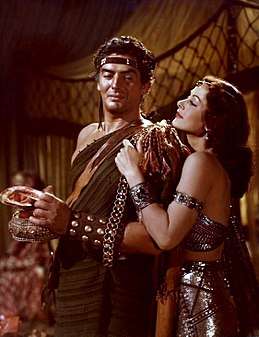
Lamarr enjoyed her greatest success playing Delilah opposite Victor Mature as the biblical strongman in Cecil B. DeMille's Samson and Delilah (1949) A massive critical and commercial success, the film also won two Academy Awards, for Best Art Direction and Best Costume Design. She won critical acclaim for her portrayal of Delilah. Showmen's Trade Review previewed the film before its release and commended Lamarr's performance: "Miss Lamarr is just about everyone's conception of the fair-skinned, dark-haired, beauteous Delilah, a role tailor-made for her, and her best acting chore to date."[47] Photoplay wrote, "As Delilah, Hedy Lamarr is treacherous and tantalizing, her charms enhanced by Technicolor."[48]
Lamarr returned to MGM for a film noir with John Hodiak, A Lady Without Passport (1950), which flopped. More popular were two pictures she made at Paramount, a Western with Ray Milland, Copper Canyon (1950), and a Bob Hope spy spoof, My Favorite Spy (1951).
Her career went into decline. She went to Italy to play multiple roles in Loves of Three Queens (1954), which she also produced. However she lacked the experience necessary to make a success of such an epic production, and lost millions of dollars when she was unable to secure distribution of the picture.
She was Joan of Arc in Irwin Allen's critically panned epic, The Story of Mankind (1957) and did episodes of Zane Grey Theatre ("Proud Woman") and Shower of Stars ("Cloak and Dagger"). Her last film was a thriller The Female Animal (1958).
Lamarr was signed to act in the 1966 film Picture Mommy Dead,[49] but was let go when she collapsed during filming from nervous exhaustion.[50] She was replaced in the role of Jessica Flagmore Shelley by Zsa Zsa Gabor.
Inventor
Although Lamarr had no formal training and was primarily self-taught, she worked in her spare time on various hobbies and inventions, which included an improved traffic stoplight and a tablet that would dissolve in water to create a carbonated drink. The beverage was unsuccessful; Lamarr herself said it tasted like Alka-Seltzer.[51][34]
Among the few who knew of Lamarr's inventiveness was aviation tycoon Howard Hughes. She suggested he change the rather square design of his aeroplanes (which she thought looked too slow) to a more streamlined shape, based on pictures of the fastest birds and fish she could find. Lamarr discussed her relationship with Hughes during an interview, saying that while they dated, he actively supported her inventive "tinkering" hobbies. He put his team of scientists and engineers at her disposal, saying they would do or make anything she asked for.[9]
Frequency-hopping spread spectrum
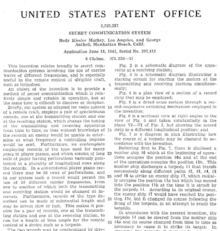
During World War II, Lamarr learned that radio-controlled torpedoes, an emerging technology in naval war, could easily be jammed and set off course.[52] She thought of creating a frequency-hopping signal that could not be tracked or jammed. She conceived an idea and contacted her friend, composer and pianist George Antheil, to help her implement it.[53] Together they developed a device for doing that, when he succeeded by synchronizing a miniaturized player-piano mechanism with radio signals.[39] They drafted designs for the frequency-hopping system, which they patented.[54][55] Antheil recalled:
We began talking about the war, which, in the late summer of 1940, was looking most extremely black. Hedy said that she did not feel very comfortable, sitting there in Hollywood and making lots of money when things were in such a state. She said that she knew a good deal about munitions and various secret weapons ... and that she was thinking seriously of quitting MGM and going to Washington, D.C., to offer her services to the newly established National Inventors Council.[29]
Their invention was granted a patent under US Patent 2,292,387 on August 11, 1942 (filed using her married name Hedy Kiesler Markey).[56] However, it was technologically difficult to implement, and at the time the US Navy was not receptive to considering inventions coming from outside the military.[34] Nevertheless, it was classified in the "red hot" category.[57] It was first adapted in 1957 to develop a sonobuoy[10] before the expiration of the patent,[1] although this was denied by the Navy. At the time of the Cuban missile crisis in 1962, an updated version of their design was installed on Navy ships.[58] Today, various spread-spectrum techniques are incorporated into Bluetooth technology and are similar to methods used in legacy versions of Wi-Fi.[11][12][13] Lamarr and Antheil's contributions were formally recognized in the late twentieth and early twenty-first centuries.
Marriages and children
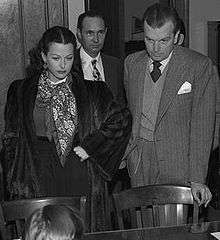
Lamarr was married and divorced six times and had three children:
- Friedrich Mandl (married 1933–37), chairman of the Hirtenberger Patronen-Fabrik[59]
- Gene Markey (married 1939–41), screenwriter and producer. She adopted a boy, James Lamarr Markey (born January 9, 1939) during her marriage with Markey. In 2001, James found out he was the out-of-wedlock son of Lamarr and actor John Loder, whom she later married as her third husband.[60][61]
- John Loder (married 1943–47), actor. James Lamarr Markey was adopted by Loder as James Lamarr Loder. During the marriage, Lamarr and Loder also had two further children:[62] Denise Loder (born January 19, 1945), married Larry Colton, a writer and former baseball player; and Anthony Loder (born February 1, 1947), married Roxanne who worked for illustrator James McMullan.[63] They both appeared in the documentary films Calling Hedy Lamarr (2004),[64] and Bombshell: The Hedy Lamarr Story (2017).
- Ernest "Ted" Stauffer (married 1951–52), nightclub owner, restaurateur, and former bandleader
- W. Howard Lee (married 1953–60), a Texas oilman (he later married film actress Gene Tierney)
- Lewis J. Boies (married 1963–65), Lamarr's divorce lawyer
Following her sixth and final divorce in 1965, Lamarr remained unmarried for the last 35 years of her life.
Later years
Lamarr became a naturalized citizen of the United States at age 38 on April 10, 1953. Her autobiography, Ecstasy and Me, was published in 1966. In a 1969 interview on The Merv Griffin Show, she said that she did not write it and claimed that much was fictional.[65] Lamarr sued the publisher in 1966 to halt publication, saying that many details were fabricated by its ghost writer, Leo Guild. She lost the suit.[66][67] In 1967, Lamarr was sued by Gene Ringgold, who asserted that the book plagiarized material from an article he had written in 1965 for Screen Facts magazine.[68]
In the late 1950s, Lamarr designed and, with husband W. Howard Lee, developed the Villa LaMarr ski resort in Aspen, Colorado.[69][70] After their divorce, her husband gained this resort.[71]
In 1966, Lamarr was arrested in Los Angeles for shoplifting. The charges were eventually dropped. In 1991, she was arrested on the same charge in Florida, this time for stealing $21.48 worth of laxatives and eye drops.[72] She pleaded no contest to avoid a court appearance, and the charges were dropped in return for her promise to refrain from breaking any laws for a year.[73]
During the 1970s, Lamarr lived in increasing seclusion. She was offered several scripts, television commercials, and stage projects, but none piqued her interest. In 1974, she filed a $10 million lawsuit against Warner Bros., claiming that the running parody of her name ("Hedley Lamarr") featured in the Mel Brooks comedy Blazing Saddles infringed her right to privacy. Brooks said he was flattered; the studio settled out of court for an undisclosed nominal sum and an apology to Lamarr for "almost using her name". Brooks said that Lamarr "never got the joke".[74][75] With her eyesight failing, Lamarr retreated from public life and settled in Miami Beach, Florida, in 1981.[15]
In 1996, a large Corel-drawn image of Lamarr won the annual cover design contest for the CorelDRAW's yearly software suite. For several years, beginning in 1997, it was featured on boxes of the software suite. Lamarr sued the company for using her image without her permission. Corel countered that she did not own rights to the image. The parties reached an undisclosed settlement in 1998.[76][77]
In 1997, Canadian company WiLAN signed an agreement with Lamarr to acquire 49% of the marketing rights of her patent, and a right of first refusal for the remaining 51% for ten quarterly payments. This was the only financial compensation she received for her frequency-hopping spread spectrum invention. A friendship ensued between her and the company's CEO, Hatim Zaghloul.[78]
Lamarr became estranged from her son, James Lamarr Loder (who believed he was adopted until 2001), when he was 12 years old. Their relationship ended abruptly, and he moved in with another family. They did not speak again for almost 50 years. Lamarr left James Loder out of her will, and he sued for control of the US$3.3 million estate left by Lamarr in 2000.[79] He eventually settled for US$50,000.[80] James Loder was the Omaha, Nebraska police officer who was charged but then acquitted of the killing of 14 year old Vivian Strong in 1969.[81][82]
Seclusion
In the last decades of her life, Lamarr communicated only by telephone with the outside world, even with her children and close friends. She often talked up to six or seven hours a day on the phone, but she spent hardly any time with anyone in person in her final years. A documentary film, Calling Hedy Lamarr, was released in 2004 and features her children Anthony Loder and Denise Loder-DeLuca.[64]
Death
Lamarr died in Casselberry, Florida,[83] on January 19, 2000, of heart disease, aged 85.[15] According to her wishes, she was cremated and her son Anthony Loder spread her ashes in Austria's Vienna Woods.[64]
Performances
Films
Source: Hedy Lamarr at the TCM Movie Database ![]()
| Year | Title | Role | Leading actor | Notes |
|---|---|---|---|---|
| 1930 | Money on the Street | Young Girl | Georg Alexander | Original title: Geld auf der Straße |
| 1931 | Storm in a Water Glass | Secretary | Paul Otto | Original title: Sturm im Wasserglas |
| 1931 | The Trunks of Mr. O.F. | Helene | Alfred Abel | Original title: Die Koffer des Herrn O.F. |
| 1932 | No Money Needed | Käthe Brandt | Heinz Rühmann | Original title: Man braucht kein Geld |
| 1933 | Ecstasy | Eva Hermann | Aribert Mog | Original title: Ekstase |
| 1938 | Algiers | Gaby | Charles Boyer | |
| 1939 | Lady of the Tropics | Manon deVargnes Carey | Robert Taylor | |
| 1940 | I Take This Woman | Georgi Gragore Decker | Spencer Tracy | |
| 1940 | Boom Town | Karen Vanmeer | Clark Gable | |
| 1940 | Comrade X | Golubka/ Theodore Yahupitz/ Lizvanetchka "Lizzie" | Clark Gable | |
| 1941 | Come Live with Me | Johnny Jones | James Stewart | |
| 1941 | Ziegfeld Girl | Sandra Kolter | James Stewart | |
| 1941 | H.M. Pulham, Esq. | Marvin Myles Ransome | Robert Young | |
| 1942 | Tortilla Flat | Dolores Ramirez | Spencer Tracy | |
| 1942 | Crossroads | Lucienne Talbot | William Powell | |
| 1942 | White Cargo | Tondelayo | Walter Pidgeon | |
| 1944 | The Heavenly Body | Vicky Whitley | William Powell | |
| 1944 | The Conspirators | Irene Von Mohr | Paul Henreid | |
| 1944 | Experiment Perilous | Allida Bederaux | George Brent | |
| 1945 | Her Highness and the Bellboy | Princess Veronica | Robert Walker | |
| 1946 | The Strange Woman | Jenny Hager | George Sanders | and Producer |
| 1947 | Dishonored Lady | Madeleine Damien | Dennis O'Keefe | and Producer |
| 1948 | Let's Live a Little | Dr. J.O. Loring | Robert Cummings | and Producer |
| 1949 | Samson and Delilah | Delilah | Victor Mature | Her first film in Technicolor |
| 1950 | A Lady Without Passport | Marianne Lorress | John Hodiak | |
| 1950 | Copper Canyon | Lisa Roselle | Ray Milland | |
| 1951 | My Favorite Spy | Lily Dalbray | Bob Hope | |
| 1954 | Loves of Three Queens | Helen of Troy, Joséphine de Beauharnais, Genevieve of Brabant |
Massimo Serato, Cesare Danova |
Original title: L'amante di Paride |
| 1957 | The Story of Mankind | Joan of Arc | Ronald Colman | |
| 1958 | The Female Animal | Vanessa Windsor | George Nader | |
Television
| Year | Series | Episode |
|---|---|---|
| 1957 | Dick Powell's Zane Grey Theatre | "Proud Woman"[84] |
Radio
Hedy Lamarr starred in the following radio dramas:
| Year | Program | Episode |
|---|---|---|
| 1941 | Lux Radio Theatre | "Algiers"[85] |
| 1941 | Lux Radio Theatre | "The Bride Came C.O.D."[86] |
| 1942 | The Screen Guild Theater | "Too Many Husbands"[15] |
| 1942 | Lux Radio Theatre | "H. M. Pulham, Esq."[87] |
| 1942 | Lux Radio Theatre | "Love Crazy"[88] |
| 1943 | The Screen Guild Theater | "Come Live with Me"[89] |
| 1944 | Lux Radio Theatre | "Casablanca"[90] |
| 1944 | Silver Theater | "She Looked Like an Angel"[15] |
| 1945 | Radio Hall of Fame | "Experiment Perilous"[91] |
| 1951 | Lux Radio Theatre | "Samson and Delilah"[92] |
Awards and honors
In 1939, Lamarr was voted the "most promising new actress" of 1938 in a poll of area voters conducted by a Philadelphia Record film critic.[93]
In 1951, British moviegoers voted Lamarr the tenth best actress of 1950,[94] for her performance in Samson and Delilah.
In 1960, Lamarr was honored with a star on the Hollywood Walk of Fame for her contribution to the motion picture industry,[95][96] at 6247 Hollywood Blvd adjacent to Vine Street where the walk is centered.
In 1997, Lamarr and George Antheil were jointly honored with the Electronic Frontier Foundation's Pioneer Award.[97]
Also in 1997, Lamarr was the first woman to receive the Invention Convention's BULBIE Gnass Spirit of Achievement Award, known as the "Oscars of inventing".[98][99]
In 2014, Lamarr and Antheil were posthumously inducted into the National Inventors Hall of Fame for frequency-hopping spread spectrum technology.[100]
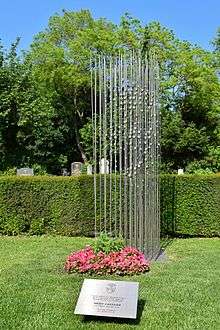
Also in 2014, Lamarr was given an honorary grave in Vienna's Central Cemetery, where the remaining portion of her ashes were buried in November, shortly before her 100th birthday.[101]
Asteroid 32730 Lamarr, discovered by Karl Reinmuth at Heidelberg Observatory in 1951, was named in her memory.[102] The official naming citation was published by the Minor Planet Center on August 27, 2019 (M.P.C. 115894).[103]
Legacy
The 2004 documentary film Calling Hedy Lamarr features her children, Anthony Loder and Denise Loder-DeLuca.[64]
In 2010, Lamarr was selected out of 150 IT people to be featured in a short film launched by the British Computer Society on May 20.[104]
Also during 2010, the New York Public Library exhibit Thirty Years of Photography at the New York Public Library included a photo of a topless Lamarr (c. 1930) by Austrian-born American photographer Trude Fleischmann.[105]
The 2017 documentary film Bombshell: The Hedy Lamarr Story, written and directed by Alexandra Dean and produced by Susan Sarandon,[106] about Lamarr's life and career as an actress and inventor, also featuring her children Anthony and Denise, among others, premiered at the 2017 Tribeca Film Festival.[39] It was released in theaters on November 24, 2017, and aired on the PBS series American Masters in May 2018. As of April 2020, it is also available on Netflix.
In popular culture
During World War II, the Office of Strategic Services invented a pyrotechnic device meant to help agents operating behind enemy lines to escape if capture seemed imminent. When the pin was pulled, it made the whistle of a falling bomb followed by a loud explosion and a large cloud of smoke, enabling the agent to make his escape. It saved the life of at least one agent. The device was codenamed the Hedy Lamarr.[107]
The Mel Brooks 1974 western parody Blazing Saddles features a male villain named "Hedley Lamarr". As a running gag, various characters mistakenly refer to him as "Hedy Lamarr" prompting him to testily reply "That's Hedley."
In the 1982 off-Broadway musical Little Shop of Horrors and subsequent film adaptation (1986), Audrey II says to Seymour in the song "Feed Me" that he can get Seymour anything he wants, including "A date with Hedy Lamarr."[108]
On the Nickelodeon show Hey Arnold!, there is a running gag in which whenever something unfortunate happens to Arnold’s grandfather, Phil, he constantly states how things would have been different if he had “married Hedy Lamarr instead!”. In one episode, it is revealed that he carries a photo of her in his wallet.
In 2008, an off-Broadway play, Frequency Hopping, features the lives of Lamarr and Antheil. The play was written and staged by Elyse Singer, and the script won a prize for best new play about science and technology from STAGE.[15][109]
In 2011, the story of Lamarr's frequency-hopping spread spectrum invention was explored in an episode of the Science Channel show Dark Matters: Twisted But True, a series that explores the darker side of scientific discovery and experimentation, which premiered on September 7.[110]
Batman co-creator Bob Kane was a great movie fan and his love for film provided the impetus for several Batman characters, among them, Catwoman. Among Kane's inspiration for Catwoman were Lamarr and actress Jean Harlow.[40] Also in 2011, Anne Hathaway revealed that she had learned that the original Catwoman was based on Lamarr, so she studied all of Lamarr's films and incorporated some of her breathing techniques into her portrayal of Catwoman in the 2012 film The Dark Knight Rises.[111]
In 2013, her work in improving wireless security was part of the premiere episode of the Discovery Channel show How We Invented the World.[112]
In 2015, on November 9, the 101st anniversary of Lamarr's birth, Google paid tribute to Lamarr's work in film and her contributions to scientific advancement with an animated Google Doodle.[113]
In 2016, Lamarr was depicted in an off-Broadway play, HEDY! The Life and Inventions of Hedy Lamarr, a one-woman show written and performed by Heather Massie.[114][115]
Also in 2016, the off-Broadway, one-actor show Stand Still and Look Stupid: The Life Story of Hedy Lamarr starring Emily Ebertz and written by Mike Broemmel went into production.[116][117]
Also in 2016, Whitney Frost, a character in the TV show Agent Carter, was inspired by Lamarr and Lauren Bacall.[118]
In 2017, actress Celia Massingham portrayed Lamarr on The CW television series Legends of Tomorrow in the sixth episode of the third season, titled "Helen Hunt". The episode is set in 1937 "Hollywoodland" and references Lamarr's reputation as an inventor. The episode aired on November 14, 2017.[119]
In 2018, actress Alyssa Sutherland portrayed Lamarr on the NBC television series Timeless in the third episode of the second season, titled "Hollywoodland". The episode aired March 25, 2018.[120]
Gal Gadot is set to portray Lamarr in an Apple TV+ limited series on her.[121]
See also
Notes
- According to Lamarr biographer Stephen Michael Shearer (pp. 8, 339), she was born in 1914, not 1913.
- When Lamarr applied for the role, she had little experience nor understood the planned filming. Anxious for the job, she signed the contract without reading it. When, during an outdoor scene, the director told her to disrobe, she protested and threatened to quit, but he said that if she refused, she would have to pay for the cost of all the scenes already filmed. To calm her, he said they were using "long shots" in any case, and no intimate details would be visible. At the preview in Prague, sitting next to the director, when she saw the numerous close-ups produced with telephoto lenses, she screamed at him for tricking her. She left the theater in tears, worried about her parents' reaction and that it might have ruined her budding career.[22]
References
- George, Alice. "Thank This World War II-Era Film Star for Your Wi-Fi". Smithsonian Magazine. Retrieved March 13, 2020.
- "Hedy Lamarr: Inventor of more than the 1st theatrical-film orgasm". Los Angeles Times. November 28, 2010. Archived from the original on January 17, 2013. Retrieved July 26, 2012.
- Katz, Ephraim. The Film Encyclopedia, 3rd ed. HarperPerennial (1998), p. 780.
- Severo, Richard (January 20, 2000). "Hedy Lamarr, Sultry Star Who Reigned in Hollywood Of 30's and 40's, Dies at 86". The New York Times. Retrieved December 24, 2018.
- Bombshell: The Hedy Lamarr Story (2017), at c. 50m35s to 52m40s.
- Haskell, Molly (December 10, 2010). "European Exotic". The New York Times. Archived from the original on September 8, 2018. Retrieved July 26, 2012.
- "Hedy Lamarr". Hollywood Walk of Fame. Retrieved December 24, 2018.
- "Movie Legend Hedy Lamarr to be Given Special Award at EFF's Sixth Annual Pioneer Awards" (Press release). Electronic Frontier Foundation. March 11, 1997. Archived from the original on October 16, 2007. Retrieved February 1, 2014.
- "How Inventive "Genius" Hedy Lamarr Became a Hollywood Tragedy" Archived April 23, 2017, at the Wayback Machine, Vanity Fair, April 20, 2017.
- "Hedy Lamarr: The Hollywood bombshell whose genius the world tried to ignore". The Independent. March 8, 2018. Retrieved March 13, 2020.
- "Hollywood star whose invention paved the way for Wi-Fi", New Scientist, December 8, 2011; retrieved February 4, 2014.
- Craddock, Ashley (March 11, 1997). "Privacy Implications of Hedy Lamarr's Idea". Wired. Condé Nast Digital. Archived from the original on August 5, 2015. Retrieved November 9, 2013.
- "short history of spread spectrum". Electronic Engineering (EE) Times. January 26, 2012. Archived from the original on August 26, 2018.
- "Spotlight – National Inventors Hall of Fame". invent.org. Archived from the original on May 1, 2015. Retrieved May 26, 2015.
- Shearer, Stephen Michael (2010). Beautiful: The Life of Hedy Lamarr. Thomas Dunne Books. ISBN 978-0-312-55098-1.
- Barton 2010, pp. 12–13.
- Bombshell: The Hedy Lamarr Story (2017), at c. 7m05s to 8m00s.
- "Role Models in Science & Engineering Achievement". USA Science Festival. Archived from the original on February 4, 2017. Retrieved February 3, 2017.
- Barton 2010, pp. 16–19.
- Barton 2010, pp. 21–22.
- Barton 2010, p. 25.
- "A Candid Portrait of Hedy Lamarr", Liberty magazine, December 1938, pp. 18–19.
- "Czech Film Series 2009–2010 – Gustav Machatý: Ecstasy" (PDF). Russian & East European Institute, Indiana University. September 2, 2009. Archived from the original (PDF) on September 11, 2009. Retrieved November 9, 2013.
- Extraordinary Women: Hedy Lamarr, documentary, 2011.
- "Bombshell: The Hedy Lamarr Story | 7 Things You Didn't Know About Hollywood Star and Inventor Hedy Lamarr | Blog | American Masters | PBS". American Masters. Retrieved April 3, 2020.
- Friedrich, Otto (1997). City of Nets: A Portrait of Hollywood in the 1940s (reprint ed.). University of California Press. pp. 12–13. ISBN 0-520-20949-4.
- "Photo of Hedy Lamarr as "Queen Sissy"". Archived from the original on April 19, 2017. Retrieved June 3, 2017 – via Pinterest.
- Rhodes, Richard (2011). Hedy's Folly: The Life and Breakthrough Inventions of Hedy Lamarr, the Most Beautiful Woman in the World. New York: Doubleday Publishing Group.
- "A Movie Star, Some Player Pianos, and Torpedoes". Lemelson Center for the Study of Invention and Innovation. November 12, 2015. Archived from the original on April 19, 2017.
- "Happy 100th birthday, Hedy Lamarr, movie star who paved way for Wi-Fi". CNET. Archived from the original on May 11, 2015. Retrieved May 26, 2015.
- "Hedy Lamarr's Great Escape". September 7, 2015. Archived from the original on April 4, 2018. Retrieved May 17, 2018.
- Donnelley, Paul. Fade to Black: 1500 Movie Obituaries, Omnibus Press (2010), p. 639.
- The Eddie Mannix Ledger, Los Angeles: Margaret Herrick Library, Center for Motion Picture Study.
- "'Most Beautiful Woman' By Day, Inventor By Night". NPR. November 22, 2011. Archived from the original on April 29, 2015. Retrieved May 26, 2015.
- Crowd”, Stephen Birmingham Author of “Our (August 23, 1970). "'Would You Believe I Was Once A Famous Star? It's the Truth!'". The New York Times. ISSN 0362-4331. Retrieved June 18, 2020.CS1 maint: extra punctuation (link)
- Pierce, David (June 2007). "Forgotten Faces: Why Some of Our Cinema Heritage Is Part of the Public Domain". Film History: An International Journal. 19 (2): 125–43. doi:10.2979/FIL.2007.19.2.125. ISSN 0892-2160. JSTOR 25165419. OCLC 15122313.
- Lumenick, Lou (December 4, 2017). "An accidental classic, 'Casablanca' turns 75". New York Post. Retrieved April 11, 2020.
- Hedy Lamarr Archived July 4, 2017, at the Wayback Machine, TCM Full Filmography
- "Bombshell: Interview with Richard Rhodes on Hedy Lamarr" Archived April 19, 2017, at the Wayback Machine, Sloan Science and Film, April 18, 2017.
- Barton, Ruth (2010). Hedy Lamarr: The Most Beautiful Woman in Film. Lexington, Kentucky: The University of Kentucky Press. p. 97. ISBN 978-0-8131-2604-3. Retrieved November 2, 2019.
- Scholtz, Robert A. (May 1982). "The Origins of Spread-Spectrum Communications". IEEE Transactions on Communications. 30 (5): 822. Bibcode:1982ITCom..30..822S. doi:10.1109/tcom.1982.1095547.
- Price, Robert (January 1983). "Further Notes and Anecdotes on Spread-Spectrum Origins". IEEE Transactions on Communications. 31 (1): 85. doi:10.1109/tcom.1983.1095725.
- Wayne, Robert L. "Moses" Speaks to His Grandchildren, Dog Ear Publishing (2014); ISBN 978-1-4575-3321-1, pg. 19.
- "Mars Film Corporation". BFI.
- Noah William Isenberg page 164. "Edgar G. Ulmer: A Filmmaker at the Margins".
- Balio, Tino (2009). United Artists: The Company Built by the Stars. University of Wisconsin Press. ISBN 978-0-299-23004-3. p203
- "The Box-Office Slant: Samson and Delilah". Showmen's Trade Review. 51 (17): 16–17. October 22, 1949. Retrieved June 23, 2019.
- Branden, Elsa (February 1950). "Shadow Stage". Photoplay. 37 (2): 26. Retrieved June 23, 2019.
- Martin, Betty (January 21, 1966). "Duo Slated for 5 Pictures". Los Angeles Times. p. c6.
- Berman, Art (February 4, 1966). "Hedy Lamarr Fired From Comeback Film: HEDY LAMARR". Los Angeles Times. p. 3.
- O'Brien, Elle. "5 facts about Hedy Lamarr, star, inventor, wartime code maker". Massive Science. Retrieved August 4, 2019.
- "Hedy Lamarr – actor, inventor, amateur engineer". The Science Show. July 5, 2014. 7 minutes in. Radio National. Archived from the original on July 5, 2014.
- George, Alice. "Thank This World War II-Era Film Star for Your Wi-Fi". Smithsonian Magazine.
- video: "Hedy Lamarr: Actress and inventor", ABC, 4 min.
- "Hedy Lamarr: Movie star, inventor of WiFi". CBS News. Archived from the original on April 9, 2016. Retrieved April 9, 2016.
- USPTO. "Patent 2,292,387 Full Text". United States Patent and Trademark Office. USPTO. Retrieved May 11, 2016.
- "Hedy Lamarr Inventor" (PDF). The New York Times. October 1, 1941. Archived from the original (PDF) on April 10, 2016. Retrieved February 1, 2014.
- Long, Tony (August 11, 2011). "This Day in Tech: Aug. 11, 1942: Actress + Piano Player=New Torpedo". Wired. Archived from the original on September 10, 2011. Retrieved October 17, 2011.
- Ivanis, Daniel J. "The stars come out: Recruiting ad featuring Hedy Lamarr creates 'buzz't". Boeing Frontiers. Archived from the original on October 29, 2012. Retrieved February 16, 2013.
- "Hedy Lamarr Adopts Baby Boy" (PDF). NY Times. November 5, 1941. Retrieved June 3, 2017.
- "Hedy News: Lamarr's Son not Adopted". New York Post. February 5, 2001. Archived from the original on June 12, 2018. Retrieved June 9, 2018.
- "Hedy Lamarr Biography". Archived from the original on December 30, 2011.
- To Tell The Truth – Hedy Lamarr + Anthony Loder + Denise Loder Deluca. YouTube. Archived from the original on June 6, 2014. Retrieved May 30, 2014.
- "Calling Hedy Lamarr". Mischief Films. Archived from the original on December 5, 2007. Retrieved December 20, 2007.
- Hedy Lamarr, 1969 TV Interview Archived October 3, 2017, at the Wayback Machine on The Merv Griffin Show, 1969
- "Hedy Lamarr Loses Fight to Stop Autobiography". The Tuscaloosa News. September 27, 1966. p. 12 – via Google Newspapers.
- "Hedy Lamarr Loses Suit to Halt Book", The New York Times, September 27, 1966, p. 74.
- "Lamarr Autobiography Prompts Plagiarism Suit", The New York Times, February 7, 1967, p. 18.
- Tim Willoughby (March 22, 2012). "Hedy Lamarr in 1950s Aspen". The Aspen Weekly Times.
- Barton 2010, p. 194.
- David Stillman Meyer (October 10, 2017). "Aspen Filmfest Docu Sheds Light on Aspen's Most Beautiful and Brilliant Part-Time Resident". Aspen Peak.
- "Google Doodle of the day: Who is Hedy Lamarr?" Archived April 19, 2017, at the Wayback Machine, Palm Beach Post, November 9, 2015.
- Salamone, Debbie (October 24, 1991). "Hedy Lamarr Won't Face Theft Charges If She Stays In Line". Archived March 24, 2012, at the Wayback Machine, Orlando Sentinel; retrieved June 10, 2010.
- Interview: Mel Brooks. Blazing Saddles (DVD). Burbank, California: Warner Brothers Pictures/Warner Home Video, 2004; ISBN 0-7907-5735-4.
- Barton 2010, p. 220.
- "Hedy Lamarr Sues Corel". April 7, 1998. Archived from the original on July 6, 2011.
- Sprenger, Polly (November 30, 1998). "Corel Caves to Actress Hedy Lamarr". Wired News. Archived from the original on June 15, 2013.
- https://archive.macleans.ca/article/2000/7/1/riding-the-wave-of-invention#!&pid=40
- "Court To Weigh Plea Of Lamarr's Estranged Son". Orlando Sentinel. Archived from the original on February 17, 2016. Retrieved May 26, 2015.
- "Hedy Lamarr's Adopted Son Trades Claim To Estate For $50,000". Archived from the original on November 13, 2016. Retrieved April 13, 2017.
- https://www.orlandosentinel.com/news/os-xpm-2000-10-30-0010300415-story.html
- https://northomahahistory.com/2015/08/22/a-history-of-north-omahas-june-1969-riot/comment-page-1/
- Moore, Roger (January 20, 2000). "Hedy Lamar: 1913–2000". Orlando Sentinel. Archived from the original on November 15, 2017. Retrieved April 27, 2018.
- Barton 2010, p. 198.
- "Lux Radio Theatre: Algiers (July 7, 1941)". YouTube. Retrieved June 23, 2019.
- "Lux Radio Theatre: The Bride Came C.O.D. (December 29, 1941)". YouTube. Retrieved June 23, 2019.
- "Lux Radio Theatre: H.M. Pulham, Esq. (July 13, 1942)". YouTube. Retrieved June 23, 2019.
- "Lux Radio Theatre: Love Crazy (October 5, 1942)". YouTube. Retrieved June 23, 2019.
- "Screen Guild Theater: Come Live With Me (August 2, 1943)". YouTube. Retrieved June 23, 2019.
- "Lux Radio Theatre: Casablanca (January 24, 1944)". YouTube. Retrieved June 23, 2019.
- "Your Radio Hall Of Fame: Experiment Perilous (February 4, 1945)". YouTube. Retrieved June 23, 2019.
- "Lux Radio Theatre: Samson And Delilah (November 19, 1951)". YouTube. Retrieved June 23, 2019.
- "Philly's Best". Boxoffice: 30–C. January 7, 1939.
- "Anna Neagle's Film Award". The Mercury (May 10, 1951). Retrieved February 24, 2018.
- "Hedy Lamarr". Hollywood Chamber of Commerce. Archived from the original on November 11, 2013. Retrieved November 9, 2013.
- "Hedy Lamarr". Los Angeles Times Hollywood Star Project. Archived from the original on November 15, 2013. Retrieved November 9, 2013.
- "Privacy Implications of Hedy Lamarr's ,Idea". WIRED. Archived from the original on May 24, 2018. Retrieved May 23, 2018.
- "1940s Film Goddess Hedy Lamarr Responsible For Pioneering Spread Spectrum". inventionconvention.com. Archived from the original on June 25, 2018. Retrieved May 23, 2018.
- "Hedy Lamarr: Invention of Spread Spectrum Technology". www.women-inventors.com. Archived from the original on November 12, 2015. Retrieved May 23, 2018.
- "Inductee Detail". National Inventors Hall of Fame. Archived from the original on November 29, 2016. Retrieved May 23, 2018.
- "Honorary grave for Hollywood pin-up". thelocal.at. Archived from the original on July 21, 2015. Retrieved May 26, 2015.
- "JPL Small-Body Database Browser: 32730 Lamarr (1951 RX)" (May 11, 2019 last obs.). Jet Propulsion Laboratory. Retrieved September 26, 2019.
- "MPC/MPO/MPS Archive". Minor Planet Center. Retrieved September 26, 2019.
- "BCS launches celebrity film campaign to raise profile of the IT industry". BCS. Archived from the original on October 19, 2014. Retrieved October 14, 2014.
- "Trude Fleischmann (American, 1895–1990): "Hedy Lamarr"". Recollection: Thirty Years of Photography at the New York Public Library. New York Public Library. Archived from the original on November 19, 2015. Retrieved November 18, 2015.
- Thorpe, Vanessa (November 12, 2017). "Film tells how Hollywood star Hedy Lamarr helped to invent wifi". The Guardian. Archived from the original on November 12, 2017. Retrieved November 12, 2017.
- Lovell, Stanley P. Of Spies and Stratagems (New York: Pocket Books), 1964.
- Alan Menken (Ft. Lee Wilkof & Ron Taylor) – Sudden Changes/ Feed Me (Git it), archived from the original on October 31, 2018, retrieved October 30, 2018
- "Frequency Hopping". Hourglass Group. Archived from the original on May 21, 2015. Retrieved June 2, 2015.
- "Positively Poisonous, Medusa's Heroin, Beauty and Brains". Dark Matters: Twisted But True. Season 2. Episode 5. September 7, 2011. Science Channel. Archived from the original on November 14, 2013. Retrieved November 9, 2013.
- "'Dark Knight Rises' star Anne Hathaway: 'Gotham City is full of grace'". Los Angeles Times. December 29, 2011. Archived from the original on July 6, 2012. Retrieved June 23, 2012.
- Genzlinger, Neil (March 18, 2013). "On the Origins of Gadgets". New York Times. Archived from the original on November 29, 2016. Retrieved December 30, 2015.
- "Hedy Lamarr's 101st birthday". Archived from the original on June 10, 2017. Retrieved June 3, 2017.
- 'HEDY! The Life & Inventions of Hedy Lamarr' Extended by Popular Demand Archived January 31, 2017, at the Wayback Machine, broadwayworld.com, October 28, 2016.
- C. E. Gerber, "Hedy! : The Life and Inventions of Hedy Lamarr Review – Simple and Effective" Archived February 2, 2017, at the Wayback Machine, lasplash.com, November 14, 2016.
- "Stand Still & look Stupid – A play in three acts". The Life Story of Hedy Lamarr. Archived from the original on March 14, 2018. Retrieved April 27, 2018.
- Varnum, Janet (March 5, 2018). "Stand Still and Look Stupid". The Ark Magazine. Retrieved April 27, 2018.
- Topel, Fred (August 6, 2015). "Exclusive: 'Marvel's Agent Carter' Producers on Season Two Villain, Hollywood Setting, and Action". /Film. Archived from the original on August 8, 2015. Retrieved August 7, 2015.
- Legends of Tomorrow ("Helen Hunt" on IMDb
- Timeless ("Hollywoodland") on IMDb
- Nast, Condé. "Gal Gadot Will Play Hedy Lamarr in a New Showtime Limited Series". Vanity Fair. Retrieved November 6, 2019.
Sources
- Barton, Ruth (2010). Hedy Lamarr: The Most Beautiful Woman in Film. Lexington: University of Kentucky Press. ISBN 978-0-8131-3654-7.CS1 maint: ref=harv (link)
Further reading
- Lamarr, Hedy (1966). Ecstasy and Me: My Life as a Woman. New York: Bartholomew House. ASIN B0007DMMN8.
- Rhodes, Richard (2012). Hedy's Folly: The Life and Breakthrough Inventions of Hedy Lamarr. New York: Doubleday. ISBN 978-0-307-74295-7.
- Shearer, Stephen Michael (2010). Beautiful: The Life of Hedy Lamarr. New York: St. Martin's Press. ISBN 978-0-312-55098-1.
- Young, Christopher (1979). The Films of Hedy Lamarr. New York: Citadel Press. ISBN 978-0-8065-0579-4.
- Benedict, Marie (2019). The Only Woman in the Room. Thorndike Press. ISBN 978-1-4328-5790-5.
External links
- Official website
- Hedy Lamarr on IMDb
- Hedy Lamarr at the National Inventors Hall of Fame
- Patent 2,292,387, by Hedy Kiesler Markey (Hedy Lamarr)
- Hedy Lamarr at Reel Classics
- Happy 100th Birthday Hedy Lamarr, Movie Star who Paved the Way for Wifi at CNet
- "Most Beautiful Woman" by Day, Inventor by Night at NPR
- "Hedy Lamarr". American Actress and Inventor. Find a Grave. March 18, 2001. Retrieved March 13, 2018.
- Hedy Lamarr before she came to Hollywood (Images)